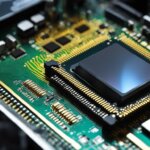Table of Contents
A DIMM (dual in-line memory module) is a crucial component in modern computer systems that enables efficient data transfer and enhances overall performance. It is a memory module that consists of one or multiple random access memory (RAM) chips mounted on a small circuit board with pins that connect it directly to the computer motherboard. DIMMs are widely used in desktop PCs, laptops, printers, and various other computing devices.
The primary purpose of DIMMs is to provide the computer with fast and volatile storage for the temporary storage of data that the CPU needs to access quickly. When the computer is powered on, the data loaded into the DIMMs allows the CPU to perform tasks effectively and swiftly.
DIMMs are designed to be natively 64 bits, facilitating rapid data transfer rates. They can store large amounts of data, allowing for faster access and retrieval when required by the system. This makes DIMMs an essential component in achieving optimal computer memory performance.
Types of DIMM
There are several types of DIMMs available for different applications. Understanding the different types of DIMMs is crucial for selecting the right memory module for your computing needs. Let’s explore the various types:
1. Unbuffered DIMMs (UDIMMs)
Unbuffered DIMMs, commonly known as UDIMMs, are primarily used in desktop and laptop computers. They offer faster data transfer speeds and lower cost compared to other types of DIMMs. However, UDIMMs are not as stable as registered memory.
2. Fully-buffered DIMMs (FB-DIMMs)
Fully-buffered DIMMs, or FB-DIMMs, are designed for systems that require large memory capacities, such as servers and workstations. These DIMMs utilize advanced memory buffer (AMB) chips to enhance reliability and improve error detection. FB-DIMMs offer high performance and are suitable for memory-intensive applications.
3. Registered DIMMs (RDIMMs)
Registered DIMMs, also known as RDIMMs or buffered memory, are commonly used in servers and other applications that prioritize stability. RDIMMs incorporate onboard memory registers that reduce strain on the CPU’s memory controller, ensuring better overall system performance.
4. Load-reduced DIMMs (LR-DIMMs)
Load-reduced DIMMs, or LR-DIMMs, utilize isolation memory buffer (iMB) technology to reduce the load on the memory controller. The iMB chip effectively isolates all electrical loading, enabling LR-DIMMs to offer increased memory capacity and improved speed. These DIMMs are suitable for high-density memory requirements.
5. Small outline DIMMs (SO-DIMMs)
Small outline DIMMs, or SO-DIMMs, are compact memory modules primarily used in portable computing devices such as laptops and tablets. They have a smaller form factor compared to other DIMM types, making them ideal for space-constrained systems. SO-DIMMs are typically 1.2 inches tall, but they can also be manufactured in a very low profile (VLP) format.
In summary, the different types of DIMMs serve various computing needs, ranging from desktops and laptops to servers and memory-intensive applications. Understanding the characteristics and functionalities of each DIMM type is essential for making informed decisions when upgrading or building a computer system.
The Future of DIMM
The future of DIMMs holds exciting developments in memory technology that will revolutionize data transfer rates, power consumption, and performance. One of the key advancements is DDR5, the next generation of memory, which promises to double the top data transfer rates and reduce power consumption compared to DDR4. This means faster and more efficient data processing, benefiting a wide range of computing applications.
In addition to DDR5, another promising innovation is non-volatile DIMMs (NVDIMMs). These memory modules are designed to retain data even during power outages, providing crucial data reliability and resilience. JEDEC, the organization responsible for the development of memory standards, is actively working on specifications for NVDIMMs, paving the way for their widespread adoption in various industries and applications.
Furthermore, the introduction of 3D XPoint memory architecture brings significant improvements to DIMM technology. This breakthrough technology offers enhanced performance and storage capacity, surpassing the limitations of traditional memory architectures. With 3D XPoint, users can expect faster data access and increased storage capabilities, enabling more efficient data-intensive tasks and accommodating the ever-growing demand for memory in modern computing.
Manufacturers are fully committed to pushing the boundaries of DIMM technology and continuously improving memory architectures. The ongoing advancements in DDR5, NVDIMMs, and 3D XPoint demonstrate the industry’s dedication to meeting the evolving needs of computing, from consumer electronics to enterprise-level systems. As our reliance on data continues to grow, DIMMs will play a pivotal role in shaping the future of memory, unleashing new possibilities for computing performance and efficiency.
FAQ
What is a DIMM?
A DIMM, which stands for dual in-line memory module, is a type of computer memory that enables fast data transfer. It is a small circuit board containing one or several random access memory (RAM) chips, connected to the computer motherboard with pins.
What types of DIMMs are available?
There are several types of DIMMs available for different applications. These include Unbuffered DIMMs (UDIMMs), Fully-buffered DIMMs (FB-DIMMs), Registered DIMMs (RDIMMs), Load-reduced DIMMs (LR-DIMMs), and Small outline DIMMs (SO-DIMMs).
What are UDIMMs used for?
UDIMMs, mainly used in desktop and laptop computers, offer faster speed and lower cost. However, they are not as stable as registered memory.
What are FB-DIMMs used for?
FB-DIMMs are used in systems that require large capacities, such as servers and workstations. They use advanced memory buffer (AMB) chips to boost reliability and improve error detection.
What are RDIMMs used for?
RDIMMs, also known as buffered memory, are often used in servers and other applications that require stability. They feature onboard memory registers that reduce strain on the CPU’s memory controller.
What are LR-DIMMs used for?
LR-DIMMs use isolation memory buffer (iMB) technology to reduce the load on the memory controller. This enhances capacity and speed, making them suitable for high-performance applications.
What are SO-DIMMs used for?
SO-DIMMs are used in portable computing devices such as laptops and tablets. They have a smaller form factor and are mainly 1.2 inches tall, but can also be made in a very low profile (VLP) format.
What is the future of DIMMs?
The future of DIMMs includes the development of DDR5, which will double the top data transfer rates and use less power than DDR4. JEDEC is also working on specifications for non-volatile DIMMs (NVDIMMs) that would retain data during a power outage. Additionally, 3D XPoint is a new memory architecture that offers increased performance and storage capacity. Manufacturers are continuously improving DIMM technology to meet the growing demand for memory in various applications.







